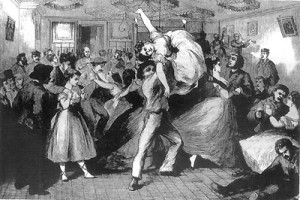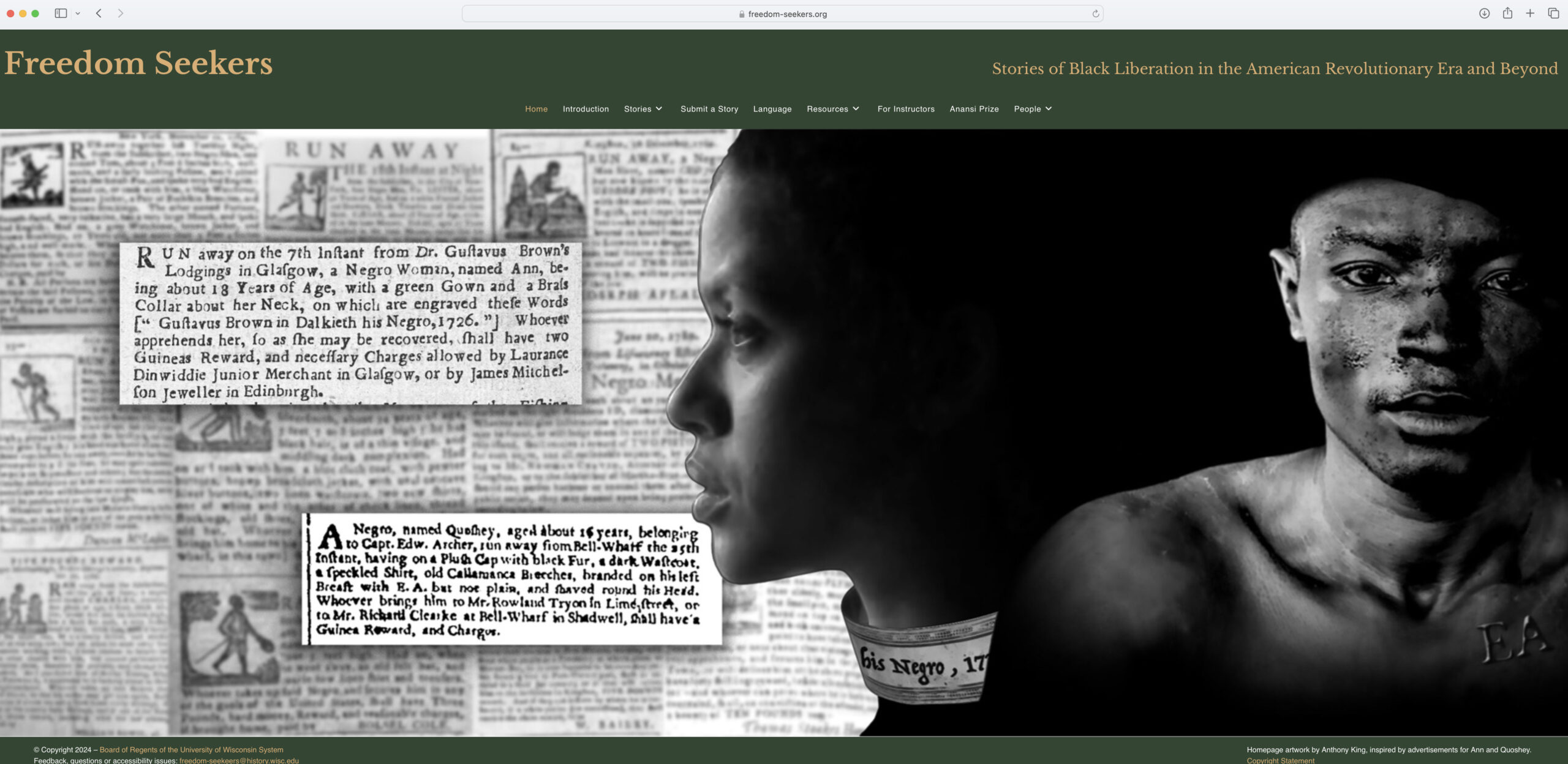Students think with their bodies
Standing in the discussion circle at the end of the first full session of “Dancing American History,” I am surprised to hear the students say they understand why the slaves danced the “ring shout.” This response is what I had hoped for, but I find it hard to believe. How could these modern-day college students even imagine what an enslaved African felt? During the dancing portion of the class it seemed like the students were anything but “feeling” the moment; I had to keep encouraging the shuffling and patting and discouraging the chatting. But in the circle they are entirely sincere: “I could see how after working so hard all day dancing like this was a release. I let go of everything that was bothering me. It was definitely both physical and spiritual.” “It took me awhile to get into it, but after you turned the lights out, I saw why they liked doing it. I felt connected to everyone else.” Such words confirm my belief that the physical act of dancing can teach us about the slave experience.
“Dancing American History: From Slavery to Hip Hop” is a senior seminar I teach at SUNY Stony Brook, which uses dance as a primary source for teaching American history. I devised this course three years ago as a pedagogical experiment stemming from my research on the relationship between Irish and African American music and dance. The premise of the class is that learning to dance as other people danced provides information—missing from other sources—that can deepen our understanding of the past. This is not a “history of dance” class. Rather, the class presents dance as an embodiment of its historical context.
The course is a blast to teach, and most of the students who are game enough to take it love it. But it is not lightweight. Instead, it balances an exhilarating physical experience with serious intellectual work. To counter the idea that fun history is not real history, I assign tough reading and demand excellent writing. Even so, there are always a few students who find the dancing more challenging than the reading and writing.
Over the course of a semester, I lead the class through two hundred years and fourteen dances. Students keep a weekly journal, reflecting on their substantial reading in both primary and secondary sources. Then, we jig in the eighteenth century, waltz in the 1840s, reel in the 1860s, “spiel” in the 1890s, Charleston in the 1920s, swing in the 1940s, and so on. The journals are meant to encourage pre-reading and informed discussion. They consist of two weekly entries: one is a response to the week’s readings, written before coming to class and brought to class to use as prompts for discussion; the other, written after class, is a record of the experience of dancing. I collect and grade the journals three times during the semester as an incentive to keep everyone reading and talking. Each session is divided into two parts. During the first half, we talk about the week’s readings and any music, illustrations, or film clips presented in class. Then, after a short break, I teach the students a dance, and we dance it! A few minutes before class ends, we gather again briefly to reflect on the historical insights dancing has given us.
Like learning the steps to a dance, the readings and discussion are really the groundwork that makes the dancing meaningful and pleasurable. Each set of texts covers a particular group of people or a notable historical process (say, for instance, Native Americans or industrialization), but the connection between the readings and the dance is not always obvious. This uncertainty makes each session resemble historical research. At the beginning of class, students often admit they have no idea what a reading, like the chapter on Scots-Irish Presbyterians in Kevin Kenny’s The American Irish: A History (New York, 2000), has to do with dancing. But they begin to figure it out during the discussion, and after we’ve danced they make more connections.
In a dance, movement and steps are like words and sentences. They are the media for communication between two or more dancers or between dancers and audiences. Dances develop out of specific social and geographic environs, replicating the society in which they become popular. For example, the Virginia reel, a group dance enjoyed in isolated frontier communities during the nineteenth century, was easy to learn and therefore inclusive, mirroring and reinforcing the farm families’ need to work together for survival.
Yet the way people move, like the way they talk, is always changing. In America, a land of immigrants and migrants, there has never been one institutionalized or traditional dance form. Old forms of dance survive or are revived, but the new setting revises their significance. Jigs and reels performed today do not function as they did at barn raisings in the 1800s. American dance is a living language rooted in cultural pasts yet continually reworked in the present. This dichotomy makes dancing a splendid document for capturing specific moments and for charting change over time.
Learning dances chronologically gives students a powerful place to store knowledge: their bodies. I use Lynn Fauley Emery’s Black Dance: From 1619 to Today (1972; London, 1988) as a basic text for the class. I also teach many of the dances she documents. Toward mid-semester, students begin to recognize in new dances African American movements and steps from earlier sessions. This kinesthetic knowledge is raw historical evidence. For example, if the new dance originates from the white community, those steps signify some kind of interaction between blacks and whites. To find out where the exchange took place, the students must return to the readings. As their physical and factual knowledge increase, they make ever-more complex connections.
The course works because it reconnects the mind and body, which are unnaturally separated in modern life. Actually doing the dances shocks the students out of their normal frame of reference. It interrupts their way of seeing and being in the world. If they don’t like doing a dance, I make them use historical knowledge to explain why our subjects did. Dancing compels them to think with their bodies, to give historical significance to their physical sensations.
Dancing also obliges the students to interact with one another. They become friends. They talk about the course outside of class. They work together. One semester, the group cohesion was so strong that when a handicapped student fell to the floor during a raucous dance his classmates just swept him up and kept on going. Dancing teaches them to value those who fearlessly join in. They begin to notice each other’s strengths. “Everyone should experience ‘the Barry,’” one student wrote in her journal, referring to a particularly enthusiastic partner.
Each week the discussions get longer and more intense as the excitement generated by the dancing permeates the class. Last semester, our discussion of the sixties moved from political protest to countercultural experimentation and ended in a lively debate over whether today’s youth are apathetic. We talked for almost two hours, which left little time to rock ’n’ roll. In journal entries for that class, several students said they wished we’d had more time to dance but did not want the discussion to end. As the semester progresses, more and more entries begin with, “I have to say that tonight’s dance was my favorite,” and I know why. Dancing has become the payoff for doing the intellectual work. It is not easy to make connections between movement and historical events, but, when they do, students find it immensely satisfying.
People often ask me how I learn all the dances. To be honest, I often just watch videotapes. If a dance is too hard for me, I invite an expert to come to class. I always hire an instructor from Swing Dance Long Island to teach the Lindy Hop, and I never teach Native American dance myself, since dance retains sacred elements in many Native communities and since many Native Americans derive their livelihood from dance performances. I have also reconstructed ragtime dances of the 1890s, like “spieling” and “ballin’ the jack,” from written descriptions. In most cases, just the basic steps will get the points across. Of course, this method can be embarrassing. I have had a history major who was also a professional ballroom-dance instructor take the class and a ballet dancer and a contra dance caller. Fortunately, rather than being put off by my limited dancing skills, each of them offered to help when I taught her dance and seemed glad to study its historical significance.
In the end, what the students get from “Dancing American History” far outweighs any mortification I might experience teaching it. To pass the course, students must write a final ten-page research paper, and, as in any class, I confront in their written work a range of technical and literary ability. But sometimes these papers amaze me. In one, a student discovered the political origins of the Zeibekiko, a dance her Greek American family always makes her do at weddings. In another, a student who conducted oral interviews on swing dancing during World War II found out his great-uncle and great-aunt met at a USO dance. In a third, a student concluded that the singing and clapping she does at her mother’s church actually stem from slave dancing. And yet, with all the marvelous ways it connects the students to history, I really teach this course because I love to dance. I also love the infectious noise that rises in the room as my students begin to learn the steps, and their ruddy cheeks and sweaty brows as they dance the dance, and their shining eyes when the dancing is done and they gather in the circle, eager to connect what they feel to what they know.
This article originally appeared in issue 6.1 (October, 2005).
April Masten teaches American history at SUNY Stony Brook. Her publications include “Shake Hands? Lilly Martin Spencer and the Politics of Art” (American Quarterly, June 2004), for which she won the Nineteenth-Century Studies Association 2005 Article Prize for interdisciplinary writing. Masten is currently researching the exchange of music and dance among African, Irish, and Native North Americans.




















